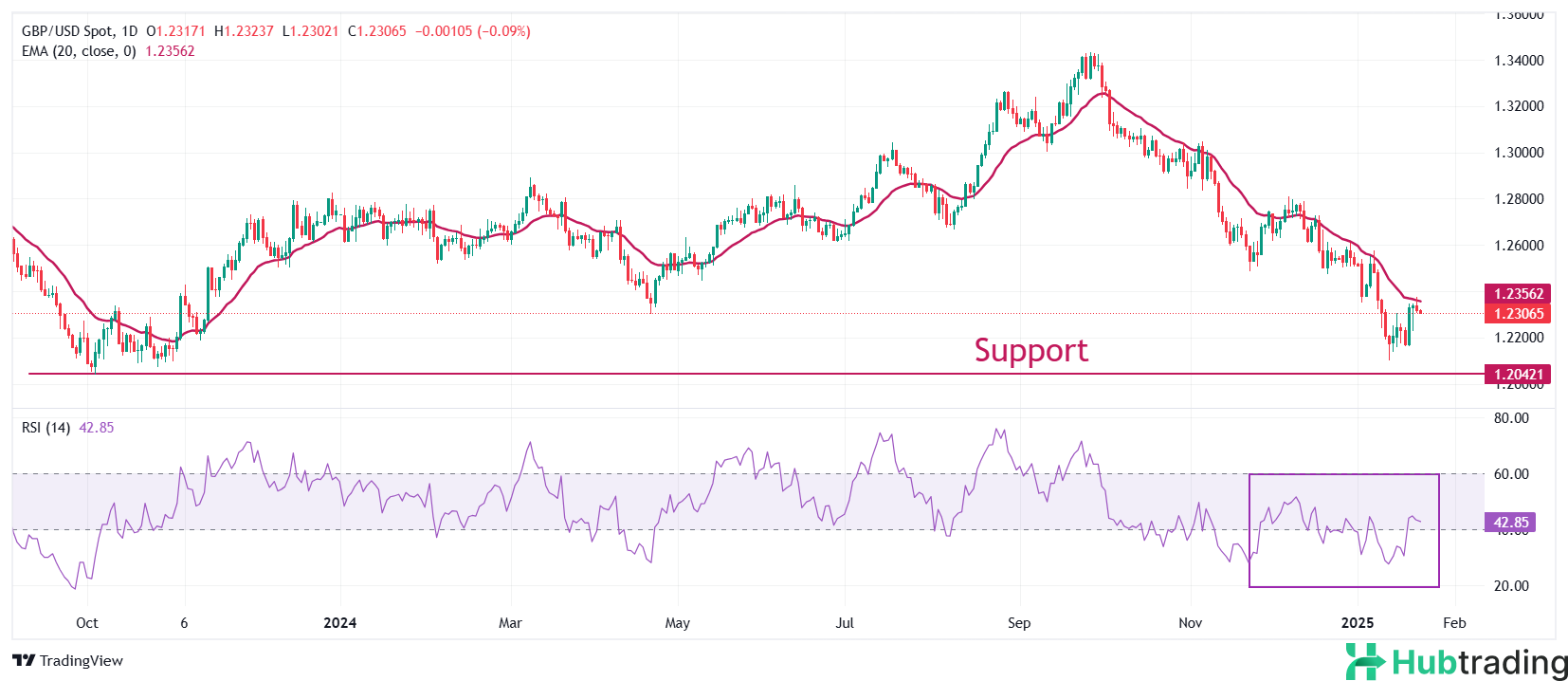- The Pound Sterling remains under pressure against major peers as concerns over the UK economic outlook persist.
- Markets anticipate a 25-basis-point rate cut by the Bank of England (BoE) in February.
- Investors await clearer details on President Trump’s tariff structure to guide their decisions.
The Pound Sterling (GBP) holds steady around 1.2300 against the US Dollar (USD) during Thursday’s European session, as the GBP/USD pair consolidates while investors await clear details on US President Donald Trump’s tariff plans. Meanwhile, the US Dollar Index (DXY), which measures the Greenback’s value against six major currencies, remains rangebound above 108.00.
So far, Trump has threatened to impose a 25% tariff on Mexico and Canada and a 10% tariff on China, with potential implementation as early as February 1. He has also hinted at targeting Europe with tariffs to address trade imbalances, though no concrete details have been provided. Before Trump’s inauguration, markets widely expected him to implement broad tariffs immediately upon taking office.
Until Trump clarifies his tariff strategy, the US Dollar is likely to trade sideways. Additionally, the Federal Reserve’s (Fed) monetary policy decision on Wednesday is unlikely to significantly reduce USD volatility, as the central bank is expected to maintain interest rates within the 4.25%-4.50% range, according to the CME FedWatch tool. However, investors will closely scrutinize the Fed’s guidance for future policy direction.
Daily Digest Market Movers: Pound Sterling Trades Cautiously Amid Expectations of a BoE Rate Cut in February
- The Pound Sterling remains cautious against major peers on Thursday as the UK’s higher-than-expected Public Sector Net Borrowing in December weighs on the economic outlook. The Office for National Statistics (ONS) reported on Wednesday that rising borrowing costs and a one-off payment for military housing repurchases significantly increased the budget deficit. This could compel Chancellor of the Exchequer Rachel Reeves to either raise taxes or cut public spending, potentially slowing the already modest UK growth rate. However, Reeves expressed optimism at the World Economic Forum (WEF) in Davos, stating, “We can get growth numbers up.”
- UK government borrowing costs have surged recently amid concerns that higher tariffs from US President Donald Trump could hamper growth prospects. This drove 30-year gilt yields to a 26-year high of 5.47% on January 14.
- Investors are now focusing on the Bank of England’s (BoE) first monetary policy decision of the year, scheduled for February 6. Markets have nearly fully priced in a 25 basis points (bps) rate cut, which would lower borrowing costs to 4.5%. Dovish expectations are driven by subdued inflation, declining December Retail Sales, and weaker labor demand during the three months ending November.
- This week, attention will also turn to the flash UK S&P Global/CIPS Purchasing Managers’ Index (PMI) data for January, set to release on Friday. The report is expected to indicate a slower pace of expansion in overall business activity.
Technical Analysis: Pound Sterling Struggles to Extend Recovery Above 20-Day EMA
The Pound Sterling (GBP) attempts to break above the 20-day Exponential Moving Average (EMA), currently near 1.2356, against the US Dollar (USD). The GBP/USD pair has rebounded after hitting a fresh one-year low of 1.2100 on January 13.
The 14-day Relative Strength Index (RSI) has climbed to approximately 43.50, recovering from the bearish 20.00-40.00 range, indicating that downside momentum has temporarily subsided.
On the downside, the pair is expected to find strong support near the October 2023 low of 1.2050. On the upside, the 20-day EMA and the psychological level of 1.2400 serve as key resistance zones.






